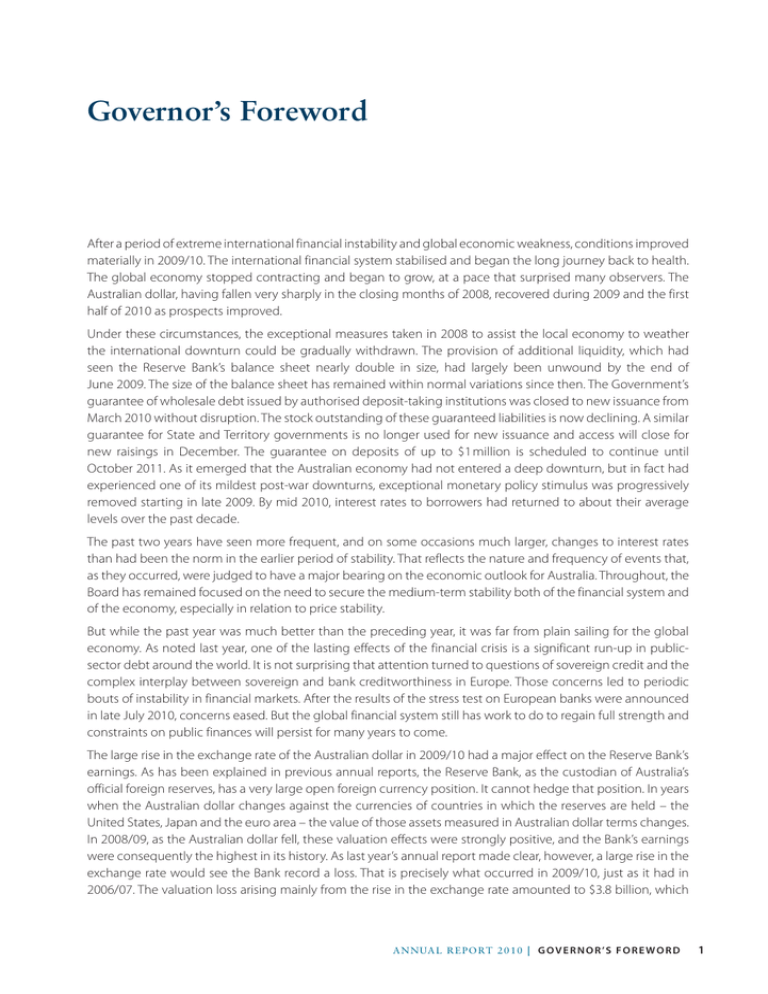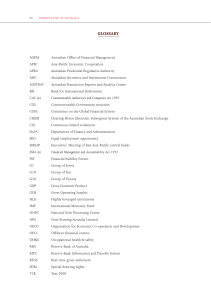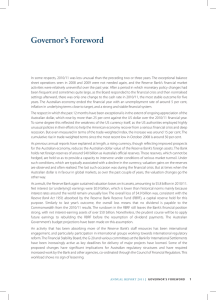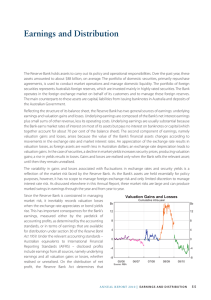Governor’s Foreword
advertisement

Governor’s Foreword After a period of extreme international financial instability and global economic weakness, conditions improved materially in 2009/10. The international financial system stabilised and began the long journey back to health. The global economy stopped contracting and began to grow, at a pace that surprised many observers. The Australian dollar, having fallen very sharply in the closing months of 2008, recovered during 2009 and the first half of 2010 as prospects improved. Under these circumstances, the exceptional measures taken in 2008 to assist the local economy to weather the international downturn could be gradually withdrawn. The provision of additional liquidity, which had seen the Reserve Bank’s balance sheet nearly double in size, had largely been unwound by the end of June 2009. The size of the balance sheet has remained within normal variations since then. The Government’s guarantee of wholesale debt issued by authorised deposit-taking institutions was closed to new issuance from March 2010 without disruption. The stock outstanding of these guaranteed liabilities is now declining. A similar guarantee for State and Territory governments is no longer used for new issuance and access will close for new raisings in December. The guarantee on deposits of up to $1 million is scheduled to continue until October 2011. As it emerged that the Australian economy had not entered a deep downturn, but in fact had experienced one of its mildest post-war downturns, exceptional monetary policy stimulus was progressively removed starting in late 2009. By mid 2010, interest rates to borrowers had returned to about their average levels over the past decade. The past two years have seen more frequent, and on some occasions much larger, changes to interest rates than had been the norm in the earlier period of stability. That reflects the nature and frequency of events that, as they occurred, were judged to have a major bearing on the economic outlook for Australia. Throughout, the Board has remained focused on the need to secure the medium-term stability both of the financial system and of the economy, especially in relation to price stability. But while the past year was much better than the preceding year, it was far from plain sailing for the global economy. As noted last year, one of the lasting effects of the financial crisis is a significant run-up in publicsector debt around the world. It is not surprising that attention turned to questions of sovereign credit and the complex interplay between sovereign and bank creditworthiness in Europe. Those concerns led to periodic bouts of instability in financial markets. After the results of the stress test on European banks were announced in late July 2010, concerns eased. But the global financial system still has work to do to regain full strength and constraints on public finances will persist for many years to come. The large rise in the exchange rate of the Australian dollar in 2009/10 had a major effect on the Reserve Bank’s earnings. As has been explained in previous annual reports, the Reserve Bank, as the custodian of Australia’s official foreign reserves, has a very large open foreign currency position. It cannot hedge that position. In years when the Australian dollar changes against the currencies of countries in which the reserves are held – the United States, Japan and the euro area – the value of those assets measured in Australian dollar terms changes. In 2008/09, as the Australian dollar fell, these valuation effects were strongly positive, and the Bank’s earnings were consequently the highest in its history. As last year’s annual report made clear, however, a large rise in the exchange rate would see the Bank record a loss. That is precisely what occurred in 2009/10, just as it had in 2006/07. The valuation loss arising mainly from the rise in the exchange rate amounted to $3.8 billion, which AN N UAL R E P O RT 2 0 1 0 | G O v e r n o r ’s f o r e w o r d 1 was the largest loss, in absolute terms, the Bank has ever experienced. Underlying earnings – at $866 million in 2009/10 – were also lower than normal because of the low level of global interest rates. The total loss, measured in terms of the accounting standards, came to $2.9 billion. The Reserve Bank Act 1959 is clear about how such losses are to be treated. In the first instance, valuation losses are absorbed by any unrealised valuation gains from earlier years, which are retained in a reserve. Any remaining loss beyond the capacity of this reserve is charged against the Reserve Bank Reserve Fund (RBRF), a capital reserve maintained for exactly such circumstances. For 2009/10, the accounting loss reduced the RBRF by $680 million. As it turned out, the drawdown was only a little larger than the transfer into the RBRF (of $577 million) approved by the Treasurer last year. Two implications follow from this outcome. The first is that because the valuation losses have exhausted the underlying earnings that would otherwise have been available, no dividend from 2009/10 is payable to the Commonwealth. Second, it will be prudent to seek to rebuild the RBRF over coming years by making transfers from future earnings. The Board has informed the Treasurer of this need and the Government’s budget estimates have been compiled accordingly. A component of the dividend earned in 2008/09 but deferred was paid to the Commonwealth as scheduled in August 2010. A highlight of the year was the 50th anniversary of the commencement of central banking operations by the Reserve Bank of Australia on 14 January 1960. A number of events were held to mark the occasion. These included an international conference and associated international official meetings, the exhibition of items of historical interest from the Bank’s archives and art collection, and the publication of a monograph on the evolution of central banking in Australia, authored by Professor Selwyn Cornish of the Australian National University. The Reserve Bank’s staff complement increased by 21 over the year, in response to several demands. In the policy areas, the more intensive engagement on financial regulatory matters and increased research effort on Asian economies added to the required numbers. On the services front, the Bank is continuing a program of upgrading the quality and resilience of the payments services it provides to the private sector and its banking services to government agencies. Overall, the Bank’s running costs rose by 4.4 per cent. The Bank’s staff served with their customary calm professionalism and high standards. The Board joins me in thanking them for their efforts. Glenn Stevens Chairman, Reserve Bank Board 16 August 2010 2 Re s erv e b ank o f Au s tral i a







